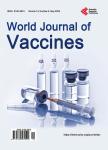Evaluation of “Indigenous Vaccine” Developed Using “Indian Bison Type” Genotype of <i>Mycobacterium avium subspecies paratuberculosis</i>Strain “S5” of Goat Origin in a Sheep Flock Endemic for Johne’s Disease: A Three Years Trial in India
Evaluation of “Indigenous Vaccine” Developed Using “Indian Bison Type” Genotype of <i>Mycobacterium avium subspecies paratuberculosis</i>Strain “S5” of Goat Origin in a Sheep Flock Endemic for Johne’s Disease: A Three Years Trial in India作者机构:Central Institute for Research on Goats Mathura Indi Central Institute for Research on Goats Mathura India Southern Regional Research Centre Central Sheep and Wool Research Institute Kodaikanal India
出 版 物:《World Journal of Vaccines》 (疫苗(英文))
年 卷 期:2013年第3卷第2期
页 面:52-59页
学科分类:1002[医学-临床医学] 100214[医学-肿瘤学] 10[医学]
主 题:Paratuberculosis Indigenous Vaccine Indian Bison Type Bharat Merino Sheep India
摘 要:“Indigenous vaccine developed from native “Indian Bison Type strain (“S5) of Mycobacterium avium subspecies paratuberculosis (MAP) of “goat origin was first time evaluated in a sheep flock of Bharat Merino breed located in Mannavanur town of Tamil Nadu in South India. Therapeutic efficacy of the vaccine was evaluated for 3 years between 2008 and 2010, on the basis of improvements in productivity (body weights, reproductive efficiency and survivability), physical condition, clinical symptoms (weakness, diarrhea, wool quality), immune response (sero-conversion) and infection load in feces (shedding). After immunization of the flock in 2008, the successive progenies of 112 and 53 lambs born in 2009 and 2010, respectively were vaccinated. Whereas, 40 lambs born to control animals were kept as unvaccinated controls. Though gain in body weights in vaccinated versus controls were not significant in 2008, growth rates were distinctly superior in Ist and IInd generations of vaccinated lambs. Reproductive performance (tupping percent) and survivability of lambs and adult sheep improved significantly. There was overall reduction in yearly morbidity (diarrhea) and mortality rates of the flock in post vaccination years. Shedding of MAP in feces was reduced in vaccinated sheep by 6.2%, 14.3% and 27.3% in 2008, 2009 and 2010 respectively, whereas shedding increased in the control sheep. Seromonitoring of the animals by “indigenous ELISA kit showed enhanced “flock immunity in successive generations. “Indigenous vaccine reduced clinical disease and shedding and improved immunity and productivity of Bharat Merino flock, endemic for Johne’s disease.



